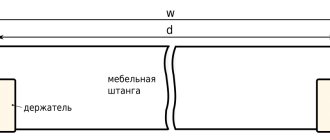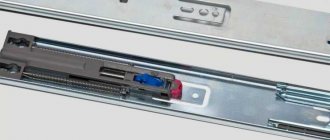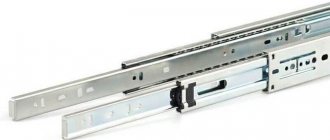SHARE ON SOCIAL NETWORKS
FacebookTwitterOkGoogle+PinterestVk
It’s hard to imagine a modern kitchen without a dishwasher. Using this unit saves time and effort. Two steps are required to make the dishwasher ready for use: installation and connection. Before starting work, you need to determine a suitable location, and also take into account many small nuances, without which it will not be possible to carry out the work correctly.
Installing a dishwasher is a rather complex process with many small nuances.
Features of installing a dishwasher depending on its type
There are several options available to ensure harmonious integration of the dishwasher into the kitchen furniture. Most often, the dishwasher (DMM) is installed in the place that was previously selected for it. All devices of this type are divided according to their dimensions into three types:
In terms of size, dishwashers come in full-size, narrow and compact sizes.
- compact;
- narrow;
- full size.
Units that belong to the first group can accommodate a small number of cookware sets (up to 5). They are most often installed under the sink. Sometimes such models are located above the countertop. The width of these models is 60 cm. They are great for people living alone. Installing dishwashers of this type is not particularly difficult. This model can also be placed in a cabinet above the sink.
Narrow PMMs are so called because of their width, which is 45 cm. Such models are more spacious, since in other dimensions they are similar to full-size machines. The number of sets that can be loaded into such a device ranges from 6 to 10. Narrow models are divided into fully and partially integrated. They are installed in a kitchen unit, the doors of which act as facades. They can have dimensions of 45 and 60 cm. The front for the dishwasher is best purchased separately.
Full-size units have a width of 65 cm and a height of 90 cm. They have the largest capacity among all types of PMM. Devices can be integrated or installed separately from the headset.
Full size dishwashers are 90 cm high and 65 cm wide
Note! Having a pre-designed diagram describing the installation of the dishwasher greatly simplifies the task. The drawing can be prepared for a specific model, for example, for installing a Bosch dishwasher (or any other brand).
Most often, companies involved in the production of kitchen furniture provide a special place in which the future dishwashing device will be located. To do this, manufacturers take the dimensions of a narrow unit as a basis and add 5 or 10 cm (on each side) to these values. If a set of kitchen furniture does not imply the installation of a PMM, then it is best to purchase a separate device.
When choosing free-standing models, it is very important to understand one nuance: the appearance of the device body must be in harmony with the design of the kitchen space. If this rule could not be followed for one reason or another, then you should choose a place for installation in the immediate vicinity of the sink. Before starting work, be sure to carefully study the instructions indicating how to install the dishwasher. Bosch is the best choice for integrating with minimal effort.
The distance from the body of the dishwasher to the back wall must be at least 5 cm. This is a very important point, failure to comply with which will lead to failure of the machine, since there will be no good ventilation.
Most often, companies producing kitchen furniture provide a special place for a dishwasher.
Electricity supply
The main power in the dishwasher is consumed by a tubular electric heater (hereinafter also referred to as heating element), which heats the water to the desired temperature. During its operation, the PMM consumes from 2 to 3 kW of electricity. You can find out about this from the technical documentation or see this parameter on a sticker located on the machine body (see photo below).
The label indicates the power of the Hansa compact PMM - 1.93 kW
In accordance with these indicators, the outlet must withstand a current of at least 16 A. Moreover, it must be located in a place to which there is easy access. There are two placement options: slightly above the furniture countertop (in the case of a built-in PMM) or in an adjacent niche, while the distance to the sink should be at least 0.5 m (due to possible water ingress). One more rule must be observed: the outlet should be located no further than 1 m from the dishwasher.
The ideal layout of communications is shown in the figure below, where:
- PMM housing.
- Area of connection to the electrical network.
- The area where the PMM connects to the water supply system.
- Drainage area.
Diagram of the correct connection of the dishwasher to communications
A dedicated line must go to the outlet from the distribution panel. If it is not laid, and the apartment has already been renovated, run the wire along the wall and cover it with a decorative box. At the same time, the appearance of the interior will not be affected. The same line can be used to connect a washing machine, provided that it does not turn on at the same time as the PMM.
One of the options for connecting the dishwasher to the mains
For installation, you need to use a cable with stranded copper conductors (for example, brand VVG-nG-Ls) with a cross-section of 2.5 mm2. A residual current device (hereinafter also referred to as RCD) must be present, along with circuit breakers that operate at a current of 16 A. By the way, RCDs and circuit breakers can be replaced with one differential circuit breaker.
The need to install these devices is due to the fact that there is a danger of a short circuit in the electrical network with water and electric shock to people.
RCD and differential circuit breaker
Parameters of the protective device: 25 A, shutdown current - 10 mA. You can use an RCD with 16 A and 30 mA leakage current. The connection is performed in the same way for PMMs of a wide variety of brands: Bosch, Siemens, Electrolux, Indesit, Whirpool and others.
How to install a dishwasher: choosing a location
Before you begin installing the dishwasher, you need to determine the location in which it will be located. It is worth considering several important points. The easiest way is to choose a place for models that are integrated into the kitchen set. Such devices are most often mounted in furniture modules, which belong to the first level (floor cabinets). An area with a small amount of space should be allocated for the dishwasher.
Compact models, if desired, can be built in a place that is most convenient to reach. They can be placed at chest level in a furniture set. Errors when choosing the location of the PMM often lead to difficulties with operation and maintenance, so first of all it is necessary to build on the type of dishwasher and the features of a particular device. This will allow you to integrate it into the kitchen ensemble as harmoniously as possible.
Note! Chinese models may have design features that influence the integration process. For example, some Medea dishwashers are equipped with special adjusting screws that are responsible for the degree of tension of the facade.
The most suitable place to install a dishwasher is the module located next to the sink. This is quite logical, since all the water supply and sewerage units that are necessary to connect the PMM are concentrated in this area. By choosing this location, there will be no problems connecting hoses to all necessary communications.
The module located next to the sink is considered the most suitable place to install a dishwasher
Models from foreign manufacturers (for example, Electrolux) are best suited for quick installation. Installing a dishwasher is often accompanied by a variety of minor setbacks. Problems arise much more often if you need to choose a place for a dishwasher in a finished set. In such a situation, there is only one thing left to do - adjust the dimensions of the furniture to the dimensions of the device. If this fails, then you will have to dismantle individual modules of the kitchen ensemble.
Thus, the most important rule is to select in advance a suitable place in which the dishwasher will be placed. This rule applies not only to dishwashers, but also to other kitchen appliances. The sketch of the kitchen set should be drawn up second.
Necessary communications
So, we have decided on the model and dimensions of the equipment. Now you need to prepare a place where the kitchen assistant will stand. If you purchase equipment at the same time as furniture for an empty room, then you will need to carefully consider and calculate the location of all communications that will be required to connect the machine, namely:
- water pipe;
- sewerage;
- electrical outlets.
A little tip: consultants in furniture stores will help you quickly design your kitchen, taking into account all the sizes and placement of cabinets and appliances.
Approximate layout of the dishwasher and other kitchen appliances
When drawing up a project, keep in mind that it would be best to place the unit next to the sink, but away from heat sources, since elevated temperatures can negatively affect the operation of the equipment.
You can develop a project on a computer using one of the many design programs. A special article will tell you about the main nuances of making kitchen furniture drawings yourself.
Instructions for preparing and installing communications and connecting to them
Before installing the dishwasher, we need to prepare the communications to which we will connect the equipment. How to do this - read the instructions.
To connect the dishwasher, you need to prepare some tools
And before you start work, prepare the necessary tools and components that you will need:
- flat-head and Phillips screwdrivers, adjustable wrench, pliers;
- level and tape measure (laser tape will be very convenient);
- screwdriver, hammer drill or drill, chisel, wall chaser;
- sewer tee;
- cold water hose (sold with the product);
- corrugation, clamps, adapter, three-way valve;
- filter (if not included in the machine);
- siphon;
- rubber gaskets;
- European standard socket (preferably with moisture protection) and socket box;
- three-core cable with a core cross-section of 1.5 mm;
- rubber cuff.
Be prepared for the fact that you may need many more little things, for example, self-tapping screws of different lengths, tape, which it is advisable to wrap around threaded parts.
Step No. 1 - connect to electricity
Appliances such as a dishwasher require a separate outlet, preferably grounded. To do this, from the junction box, which is usually located under the ceiling, you need to run a wire using hidden or surface (open) mounting, that is, in a groove or cable channel to the expected location of the outlet. It should be taken into account that the distance from the installation site of the machine to the socket should be no more than one and a half meters, since according to the standard, the cord length of the product is usually 1.5 meters.
It is mandatory to equip the dishwasher with a separate outlet.
Important! Before and during electrical installation work, it is necessary to de-energize live elements (turn off the circuit breaker in the panel). If you do not have the necessary experience, then electrical installation work must be entrusted to a qualified specialist.
The dishwasher requires a separate outlet, as safety rules dictate.
Hidden installation
Hidden installation is carried out in a room where the walls are not yet covered with a finishing decorative coating, for example, wallpaper or tiles. This type of work involves hiding the electrical cable in the wall. Using a wall chaser and a hammer drill, we select a groove and a niche for the socket box in the wall.
Work can be carried out on bare walls that have not yet been painted or even leveled
We install a socket box in a niche using construction adhesive (liquid nails, tile adhesive, gypsum mortar, etc. are suitable), and for a more durable fixation we tighten it to the wall with self-tapping screws.
We lay the copper cable in the groove, connect it on one side in the distribution box, and connect the socket to the other and secure it in the socket box. We fill the groove with a building mixture (gypsum, alabaster, putty, etc.). We level it and sand it after drying. During the final finishing of the walls, such wiring will be completely invisible.
So-called open installation can also be carried out, in which the installation of the machine will be carried out in a room with ready-made repairs
Outdoor installation
Open installation is used for finished repairs, so as not to spoil the appearance of the walls with grooves. With this type of work, a cable channel of the required cross-section and an external socket are mounted from the distribution box to the intended location of the socket to the wall. Next, the cable is connected in the same way as the hidden wiring option.
Installation of cable channel
After completing the installation of electrical wiring, you should turn on the current supply and perform a test run of household appliances.
Step No. 2 - connect the water supply
Before connecting the water supply to the machine, turn off the water supply valve to the house. This faucet is most often located in the bathroom. Next, at the connection point of one of the water consumers (washing machine, cold or hot water tap, filter), we install a tee with a three-way corner valve, restore the water supply to the existing consumer and connect the inlet hose of our washing equipment. Please note that if the threads or diameter of the tee and hose do not match, you will need an adapter.
At this stage the water supply will be connected
If you use rigid pipes instead of an inlet hose, you should install filters for rough water purification in front of the three-way tap in order to extend the correct operation of the dishwasher for a longer period.
It is better to use a flexible hose when connecting
There is a simpler connection option - this is a direct connection of the inlet hose directly to the faucet on the sink. But this method has a significant drawback - the inability to use water while the machine is running and the unattractive appearance of the hose.
The dishwasher must be connected directly to cold water
Many people have a question: what kind of water to connect the dishwasher to? It would be more correct to connect to a cold one, since each unit has several programs and corresponding temperature conditions, that is, the machine itself will heat the water to the required temperature.
But I must say that you can also connect to hot water. This is done in order to save energy consumption for heating water by the machine. Although here it is worth weighing the pros and cons of such savings, especially if you use central heating and water heating.
Step No. 3 - connect the sewer
The last important step in connecting the dishwasher to communication networks is drainage, or, in other words, connection to the sewerage system. There are two possible options for performing this operation.
- Using a tee.
- Install a siphon.
There are several options for arranging a drainage system
. Let's consider each of the options. Installing a tee is not the most successful way, but it happens that there is no other option. It is used if the equipment is installed at some distance from the sink, and since the hose of the unit cannot be extended, the option of inserting an oblique tee into the sewer pipe as close as possible to the machine remains the only correct one.
This is not an easy job, so try to follow the recommendations of specialists related to the installation of this system
We insert a rubber sealing collar into the tee, which serves to seal the connection between the drainage hose and the sewer, as well as to prevent unpleasant odors from entering the kitchen from the pipe. We insert the dishwasher drain hose into the cuff, into which it will be securely fixed and water leakage during operation of the device is excluded.
To avoid unpleasant smells from the sewer getting into the dishwasher chamber, it is necessary to create a bend in the drain hose - a water seal, that is, lower part of the hose below the level of the insert into the tee.
The second option with installing a siphon is simpler and more reliable. To do this, you need to replace the regular siphon under the sink with a model with an additional pipe. We connect the hose, but straight, without kinks, to the siphon and, for reliability, secure the connection with a clamp.
You can simply and quickly install a siphon, and the system will work with a bang
Installing a built-in dishwasher: preparing tools and materials
Most manufacturers of dishwashers include instructions for the units. Such manuals may indicate what tools and materials are needed to integrate the dishwasher into the kitchen ensemble. However, such instructions are not always included. Before starting work, you need to prepare the following tools:
- electric drill;
- screwdriver;
- Screwdriver Set;
- chisel;
- regular hammer;
- pliers;
- level.
The tools that will be needed to install the unit are an electric drill, screwdrivers, a screwdriver, a hammer, a level, and pliers.
Instead of a drill, you can use a hammer drill to install the dishwasher yourself. Screwdrivers should be prepared not only with flat tips, but also with Phillips heads. It is quite inconvenient to use a regular level in such work. Experts recommend using laser, if possible. You will also need to prepare some auxiliary tools: a pencil, a tape measure and a construction square.
Helpful information! Installing a dishwasher into furniture is one of the stages of its integration. If it is necessary to connect the PMM to communications, then the list of tools requires addition.
The parts that will be used to connect the device should not be used, since their reliability is significantly less than that of new ones. It is especially not recommended to use used parts when installing Bosch dishwashers. It is quite problematic to carry out all stages of installation and connection with your own hands, so it is recommended to study photo and video materials related to this issue.
Dishwasher installation rules and some useful tips
Before purchasing and installing a dishwasher, you need to measure the location that was previously chosen for it. The check is carried out using a construction tape. An even better solution is to take a measurement before purchasing the unit. How to find out the size of the PMM? As a rule, the dimensions of products are indicated on the websites of manufacturers and companies involved in their sale. If the size of the niche exceeds the dimensions of the dishwasher, then you can adjust the height of the device using the legs.
Before purchasing a dishwasher, you need to measure the location you have chosen to install it.
It is very important to remember that some PMM models are highly sensitive to tilt angles. Even at the slightest angle (2 degrees), such dishwashers may experience interruptions in operation. This category includes products from Hotpoint Ariston, as well as Indesit dishwashers. The instructions that come with them are a must read, as they contain many important nuances, including those related to installation.
Before proceeding with the integration of the device, it is recommended to place a metal plate under the tabletop. This measure is necessary to protect the wooden material from steam. Devices that are fully integrated into furniture most often include such a plate, but it is easy to make it yourself.
You can install a compact dishwasher under the countertop. Some of the best devices of this type are models produced by. Installing a dishwasher of this type is very simple, due to its size.
Most dishwashers come with special parts that are used when hanging the door. To carry out installation correctly, it is recommended to check preliminary calculations, wiring diagram and other details several times in a row.
Special parts are included for hanging the door
Functionality check
After installing the outlet for connecting the dishwasher and connecting it to the water supply and sewerage system, you need to conduct a dry test of your new item.
- You should check:
- the speed of pouring water into the machine;
- heating the incoming water;
- operation of the dish drying mode.
The operation of all modes of the machine should be checked without dishes, but using detergent and reducing salt in accordance with its operating instructions. You should also carefully check all connections of pipes and hoses for leaks again.
After you have succeeded in connecting the dishwasher yourself, following all the recommendations in the installation manual, you can install the kitchen furniture that was moved during operation into its place, and attach the closing panel to the new machine.
Important Features
- In order to reliably connect the device, you must:
- install a water filter. Due to this, debris and rust from the water supply will not get into the machine, which negatively affect its operation;
- Do not connect the device to hot water supply. Hot water is usually of worse quality than cold water. Mechanical impurities that it contains will negatively affect work;
- Do not connect the machine to the boiler. There will be no savings from this - the water heater will still turn on periodically to heat the water. And residents will have to use cold tap water while the machine is running;
- use a check valve when connecting the sewerage system. This will protect against sewage being sucked into the machine;
- when connecting the drain hose to the drainage system, the water drainage circuit is bent so that water from the sink does not enter the machine;
- carefully check the tightness of the connected parts;
- It is advisable to purchase taps from bronze. This material is more durable than plastic;
- Avoid using extension cords to connect the device to power. The machine is a fairly powerful device, so such a connection can lead to a fire.
These simple recommendations will help you avoid common mistakes when connecting a dishwasher to water supply and sewerage.
When installing, you must follow the instructions that came with the device. You should check the reliability and tightness of all connected parts several times. If difficulties arise, it is better to contact specialists than to fix the breakdown later.
Author: Sergey Vladimirovich, electrical engineer. More about the author.
Optimal dimensions of dishwashers for installation
The largest percentage of dishwashers are 60 cm wide. Such devices can cover the needs of any family. There are also narrow models suitable for embedding, the width of which is 45 cm. It is worth saying that devices with a width of 448 mm have good functionality, not much different from standard models.
The height of narrow dishwashers ranges from 815 to 875 mm. These values were not taken by chance - they were selected in accordance with the standard height of the cabinets included in the kitchen set. When drawing up an installation diagram for a dishwasher, it is worth taking into account not only its dimensions, but also the small margin that the niche should have.
Note! If the kitchen furniture was made to order, you should be careful. Standardized devices may not be suitable for this type of headset. It is recommended to take your own measurements of the niches and compare them with the dimensions of the device.
The easiest way to integrate a 45 cm built-in dishwasher is to install such devices in a matter of hours. The depth of dishwashing units is most often 55 cm. On sale you can find models that differ in height and depth. You should pay attention to the dimensions before purchasing a PMM.
Optimal dimensions for installing dishwashers: height – 82 cm, width – 60 cm, depth – 58 cm
How to integrate a dishwasher into the kitchen: integration into the cabinet
The cabinet located next to the sink must have a width greater than 45 cm. In such a situation, there is no need to come up with complex installation diagrams; you just need to install it into the adjacent module. When purchasing products from some brands, you should be aware that they require the installation of a special siphon when connecting (for example, Electrolux devices). Videos of installing a dishwasher of this type can be easily found on the Internet.
To prepare the lower cabinet for installation, you will need to do several manipulations. First of all, you need to remove the transverse partitions (shelves) from the cabinet, and also dismantle the back wall. The bottom panel is removed only if necessary, for example, if the height of the module itself is not enough to accommodate the dishwasher. To fix the case, it will need to be positioned strictly in a vertical plane. For this, adjustable legs and a building level are used.
If you wish, you can call a specialist who will do the job professionally. However, this will come with additional costs. The cost of installing a dishwasher depends on many factors: model, location, technical difficulties, etc.
Don’t forget about the front panel, which performs a decorative function and contributes to the harmonious integration of the dishwasher into the kitchen set. The facade is usually made from a cabinet door. However, it can also be purchased separately (to order). Devices that are part of the partially integrated group do not require a decorative front panel.
To prepare the lower cabinet for installation, you will need to remove the transverse partitions and dismantle the back wall
Installing a dishwasher in a separate module
Sometimes there are situations when it is not possible to allocate free space for installing new kitchen appliances. In this case, you can place an order for a separate module that will complement the existing kitchen ensemble. However, the rules regarding its location are the same. It must be located in close proximity to water supply and sewerage.
Related article:
Built-in dishwasher: modern appliances for a comfortable life
Varieties of models according to installation method and dimensions. Functionality of compact devices. Manufacturers and prices.
Thus, it is possible to transfer equipment that was previously located near the sink into the new module, and integrate a dishwashing unit into the old one. In this case, everything will depend on the features of the installation. Built-in dishwashers must be leveled and secured. This is required to ensure that the device does not produce vibrations during operation. If you ignore the fixation of the PMM, then it will make a lot of noise and move the cabinet.
Helpful information! The hoses located behind, in the space between the rear wall of the dishwasher body and the wall, must run parallel to the surfaces. Access to them must be free so that problems do not arise if it is necessary to replace a failed element.
When connecting certain models, you must carefully read the instructions. Bosch dishwashers, as well as other devices from popular brands, are sometimes quite difficult to integrate into an old set. To avoid having to change furniture, you need to study the issue of “compatibility” at the stage of choosing a PMM.
Access to hoses supplying and removing water in a separate module must be free
If the unit is located under a common kitchen countertop, maintenance becomes more complicated. A communication problem that arises in such a situation will require dismantling the dishwasher unit.
How to connect to the drain
You need to install a new siphon with a separate pipe under the kitchen sink. The drain circuit is connected to it.
This takes into account two important requirements:
- The drain circuit should cut into the siphon at an angle. In this case, most of the water will flow away by gravity.
- At the connection point of the circuit, you need to additionally create a small bend to prevent water from being drawn from the sink.
If the PMM is located far from the water source, you will have to install another tee. A hose will go from it to the siphon under the sink.
What to do if embedding is not practical
Some kitchen sets do not provide the possibility of installing a dishwasher. In addition, there may simply not be free space in the furniture. What to do in this case? In such a situation, it is best to purchase a freestanding model.
Dishwashing units of this type do not require complex integration work, so this option is perfect for people who do not want to spend a lot of time fiddling with the installation. There are three placement methods for freestanding devices:
- on the floor;
- into a niche;
- on the tabletop.
The best models, installed separately, are also produced by Electrolux. Installing a dishwasher of this type will not cause any particular difficulties. In this case, all work is reduced, as a rule, only to connecting to the power grid and other communications.
If it is not possible to install a dishwasher in your kitchen unit, you can purchase a separate model
You can completely remake some of the modules that are part of the kitchen ensemble. Transferring communications is also possible, but this is quite labor-intensive work. Usually this option is chosen last, when it is necessary to integrate a free-standing model and install a decorative facade on its front side.
Preparing for work after installation
So, all communications are connected to the PMM, and the device is built into the kitchen set. But don’t rush to load the dishes into the trays - you need to set up the device before the first start.
Setup consists of the following steps:
- Set the salt flow level according to the water hardness. The harder the water, the higher the level needs to be set. You can determine the hardness parameter using a special test (visually hard water can be determined by white stains on the sink).
- Pour salt into a container. It is located at the bottom of the machine and is closed with a separate lid. Before the first wash, you need to fill this compartment to the top with water and do not forget to screw the lid on.
- Pour rinse aid into the reservoir and add detergent. The rinse aid consumption is adjustable - for the first washes it is better to leave it at medium, but then adjust it - increase it if the dishes do not shine or dry slowly.
When you first turn on the PMM, the indicators will most likely light up, indicating the need to fill the compartment with salt and rinse aid.
After filling, the indicators should go out, and then you can start loading dishes and washing. After the first cycle, it is necessary to carefully check the connections between the hoses and the drain in order to immediately detect and eliminate possible leaks.
How to install a dishwasher: checking the contents and unpacking
Preparing for installation of a dishwasher includes two more stages, in addition to choosing a location: unpacking and checking the contents. It is recommended that unpacking be carried out in the presence of employees of the company from which the unit was purchased. This is necessary in order to check the presence of all parts necessary for installation. If there is a problem with the packaging, then you must inform the company’s employees about it.
Note! You also need to check the availability of instructions (necessarily in Russian). Without it, it is much more difficult to independently understand the design features of a particular model.
If necessary, you can try looking for installation instructions on the company's website. Many well-known brands add them to the product description (for example, Bosch). Dishwasher instructions are very important, so don't ignore this point.
When checking the package, you need to pay attention to the presence of instructions in Russian
In addition to the dishwasher itself, the kit often includes parts that are necessary for the correct installation of decorative trims. It is also necessary to check the presence of retaining elements, a rubber apron used for protection, and gaskets with hoses. The latter are needed when connecting the device.
Dishwasher: installing a built-in model
Before you begin integrating the built-in model into the suite, you need to once again make sure that the cabinet has the appropriate dimensions. You will need to make holes in its walls through which hoses will pass connecting the device to the communications. Installation is carried out in stages. Let's consider this process using the example of a Bosch dishwasher. Installation of the built-in model requires care.
So, the first step of installing an integrated PMM involves its location opposite the niche that was chosen to place the device. Then you will need to pull the hoses responsible for supplying and removing water through the holes. This is to ensure that the hoses are the correct length. If necessary, they will need to be lengthened.
The next step in installing a Bosch dishwasher (or any other) requires the use of instructions. You will need to glue a special film to the inside of the tabletop. It will protect the wooden material from moisture. Then you need to fix the tapes needed for sealing along the edges.
Before installing the built-in model into the suite, you need to make sure once again that the cabinet has the appropriate dimensions
Next, the mounting plate and special damping elements are installed. The latter are used to dampen vibration of the dishwasher. The next step is to adjust the height of the legs. The unit body must be positioned strictly vertically. After this, use a tape measure to check the distance from the walls of the niche to the edges of the PMM.
Note! Dishwasher sets often include soundproofing material. It is fixed at the bottom of the niche. Without soundproofing material, the device will make too much noise during operation.
The next stage is the installation of decorative elements. Trims can be custom-made or made yourself from the front parts of the cabinet. To make a decorative facade, it is necessary to adjust the doors to the dimensions. To do this, it is recommended to study the corresponding video. The installation of the built-in dishwasher is nearing completion. The linings are fixed using self-tapping screws, which often come complete with other auxiliary elements. After installing the front part, the PMM is connected and a test run is performed.
Water drainage
Once everything is prepared, you can begin connecting the machine to the sewer system. To do this, you need to install a siphon equipped with a fitting and connect a drain hose to the latter. This, at first glance, simple procedure for organizing a drain requires compliance with two important conditions.
The first condition is that you need to make an upper bend, as shown in the image below, this will prevent water from entering the sink bowl into the PMM.
Illustration of performing an upper bend
The second condition is that the elbow of the water seal on the drain should be as deep as possible with a short bend. This is done to ensure that air from the sewer system does not enter the device. If you do not install a water seal, the dishes may have an unpleasant characteristic odor after washing. The correct water seal is shown below.
An example of organizing a water seal
We do not recommend implementing the method of organizing a drain from a stationary PMM directly into a sink, since the load on the pump increases significantly. We will not even consider options for connecting directly to the sewer, since this is absolutely wrong.
How to Install a Built-in Dishwasher: Cabinet Remodel
When integrating a dishwasher into a cabinet, you need to understand exactly how this procedure should be carried out. Let us consider in detail the sequence of actions that allow you to install the PMM in one of the lower compartments of the furniture set. First, you need to remove the bottom shelf from the cabinet, after which the front plinth is dismantled.
First, the bottom shelf is removed from the cabinet, and then the front plinth is dismantled
Then you can remove the doors. It is important to understand that the walls, the back panel, and the top must remain. The video “Installing a Bosch dishwasher” will allow you to visually familiarize yourself with the integration process. The instructions that are given in it greatly simplify the work.
All dishwashers have the ability to be fixed to the countertop and walls located on the sides. However, each manufacturer produces individual retaining elements, so there are no universal recommendations in this regard. It is necessary to start from a specific model.
Particular attention should be paid to methods of fixing domestic models (for example, “Hephaestus”). Dishwashers are characterized by good build quality, but when integrating them into a cabinet, various problems may arise due to design features. Mounting methods also depend on the type of furniture.
The dishwasher unit is usually fixed to the cabinet walls using polymer inserts. Their number is most often 4 pieces. They should be located on both sides (bottom and top). A dishwasher installed in this way not only has good stability, but also produces less vibration.
The dishwasher is fixed to the cabinet walls using polymer inserts
Some models do not provide for the use of such a number of polymer liners. Some devices can be cited as an example. Installation of built-in dishwashers of this type is carried out using only two inserts, which are located in the upper part of the cabinet (under the countertop).
There is another common situation to consider. If the kitchen countertop is solid, the cabinet must be completely dismantled. Thus, the device will be placed between two walls. The bottom panel in this situation is not mandatory, but can be removed if desired.
Connecting hoses and testing
We connect the hoses to the machine at the very end, but before the side fastening is made.
The housing moves forward to provide access to all components. Both hoses are usually attached to the body on one side, at the top or bottom.
They protrude a few centimeters, and to provide space in the closet, the back wall is usually simply removed.
The connection is made as described above: the hoses are inserted into the holes and secured with union nuts or clamps. No special tool is needed for fixing; everything is done manually, with a screwdriver or pliers
Once connected, the machine is placed in place for testing. We turn on the machine on the panel, then plug into the socket, ensure the water supply and press the “ Test ” or “ Start ” button. How to perform testing correctly is explained in the instructions.
If there are no leaks, the machine does not hit the countertop or walls, and the test wash cycle went through without incident, then you succeeded in installing the dishwasher yourself.
But before you start using it, it is advisable to familiarize yourself with the rules of operation and maintenance of the machine.
How to install a front on a dishwasher: details of the process
The front part of the integrated devices must be closed using a panel, which is most often made to order. It must fully comply with the design of the room. In order to install such a panel, a special fixing element and a pattern are included with the PMM.
Note! To install the front on the dishwasher, you need to take a paper model. It marks all the necessary areas, as well as the places where the clamps will be installed. This sheet is applied to the front door, and the decorative element is marked on it. All necessary zones can be marked using a regular awl.
To install the front panel, the dishwashers come with a template and a special clamp.
Next, you will need to remove the paper model and drill holes for the screws. Locks are installed in the required places, as well as the front door handle. This manual is suitable both for installing fronts for 45 cm dishwashers, and for installing larger front parts.
After assembling the panel, you can begin installing it. To do this, you will need to fix the decorative element on the doors of the dishwasher and screw pre-prepared screws into it.
DIY installation of a built-in dishwasher: protecting the countertop
All dishwashers have one design feature that leads to damage to the countertop during PMM operation. Dishwashers produce steam and moisture that rises and impacts the countertop. This happens when the door is opened.
In order to protect the countertop, you will need to install protection from steam and moisture. For this purpose, various materials are used, such as film, plastic, metal sheets. In order to protect the tabletop from moisture, you can use tape.
You can protect your countertop by installing special protection against steam and moisture.
The machines that are produced are equipped with special plates made of metal. The Bosch dishwasher installation instructions will help you find out what steps need to be taken to install the plate.
Products from other well-known brands can also be equipped with plastic or metal plates, but film is more common. It is glued to the bottom of the tabletop. After installing the protective material, the side gaskets are installed and the height of the machine is adjusted.
How to install a dishwasher: what else needs to be considered
A special niche can be located in the kitchen, prepared for the integration of other appliances (oven, microwave, etc.). It can be used to install PMM. But only a compact device will fit into a small niche, which is worth considering when choosing it. If furniture with a free cavity is located far from the sewerage system and water supply, then you will need to prepare flexible hoses for connection.
Combined units of equipment can also be integrated into the kitchen set. For example, stoves with dishwashers are very popular. They are quite easy to install in a modern set, but problems may arise when installed in old kitchen furniture.
It is recommended to install a product with adjustable legs in the fully lowered position
What other installation aspects should be considered? At the installation stage, it is necessary to ground the dishwasher. There is also a rule that prohibits placing PMMs in close proximity to the hob. If the kitchen has quite a lot of expensive equipment, then experts recommend taking care of installing a stabilizer.
Helpful information! Do not forget about the need for installation instructions for the dishwasher. Bosch, Electrolux and other large companies describe in detail all the nuances of installing and using their equipment.
It is recommended that the unit, which has adjustable legs, be installed in such a way that it is lowered all the way. It is advisable to install a separate socket to connect the dishwasher to the mains, since the power of this device is quite high.











